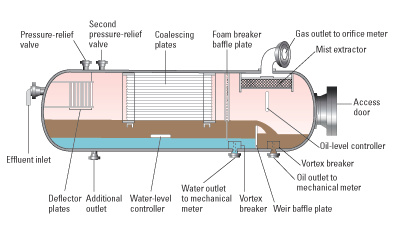1. S. [Instalaciones de producción]
Recipiente cilíndrico o esférico que se utiliza para separar petróleo, gas y agua del flujo total de fluido producido por un pozo. Los separadores pueden ser horizontales o verticales. Se pueden clasificar en separadores bifásicos y trifásicos (comúnmente llamados separadores de agua libre). El tipo bifásico sólo trata petróleo y gas, mientras que el trifásico trata petróleo, agua y gas. Además, los separadores se pueden clasificar según su presión operativa. Las unidades de baja presión manejan presiones de 10 a 180 psi [69 a 1241 kPa]. Los separadores de media presión operan de 230 a 700 psi [1586 a 4826 kPa]. Las unidades de alta presión manejan presiones de 975 a 1500 psi [6722 a 10.342 kPa]. La segregación gravitacional es la más importante que ocurre durante la separación, lo que significa que el fluido más pesado se decanta en el fondo y el fluido más liviano se eleva hacia la superficie. Asimismo, dentro del recipiente, el grado de separación entre el gas y el líquido dependerá de la presión operativa del separador, el tiempo de residencia de la mezcla de fluido y el tipo de flujo del fluido. El flujo turbulento permite que escapen más burbujas que el flujo laminar.
Ver: separador de agua libre, separador horizontal, separador de petróleo y gas, separador esférico, separación por etapa, separador trifásico, separador bifásico, separador vertical
